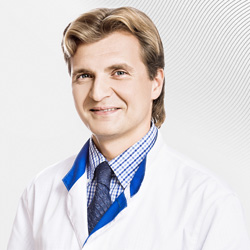
The EMC Children’s Clinic is fully equipped for performing comprehensive diagnostics and treatment of eye disorders in children:
- The modern equipment enables examination without dilation which minimizes discomfort and reduces consultation time;
- The individual eye training programs permit to compensate for variety of visual impairments present with strabismus, astigmatism, and other pathologies. The training classes are held in the form of games and children really enjoy them;
- The latest therapeutic and surgical methods are applied for the treatment of amblyopia, mayopia and strabismus.
All stuff of EMC Children's clinic speaks English.
The most common reason for visits to the ophthalmologist:
- parents notice the deterioration of child’s vision (a toddler may bring small objects very close to his eyes, or come too close to TV screen; in school, a child has difficulty reading from the board or gets tired easily while reading books);
- a child has strabismus and/or nystagmus (involuntary rapid rhythmic movements of eye globes) diagnosed;
- the anomalies of refraction (myopia, hyperopia, astigmatism) or lack of visual acuity found at the general physical examination.
The EMC Children’s Clinic has a computer-based complex for the the diagnosis and treatment of binocular and stereoscopic vision (Eye Training ). The training of ‘lazy eye’ and the training aimed at increasing visual acuity to match age norms are conducted is a game form. With strabismus, the balance of visual images between eyes is restored, the tolerance and the space perception are increased.
Strabismus with a very early onset (the first months of the child's life) is usually related to a complicated pregnancy and childbirth. Sometimes strabismus could be caused by congential disorders such as: cataract and various inflammatory diseases of the eye. Another kind of strabismus (usually a converging type) is associated with high hyperopia, which is generally diagnosed in children over three years-old. The prevention of this type of strabismus is the early detection of pathology of refraction (usually long-sightedness or astigmatism), promptly recommended correction using the orthoptic and pleoptic glasses.
If conservative treatment does not produce the desired results, the surgical correction of strabismus is recommended, after which the therapeutic treatment is resumed. Despite the surgery, wearing glasses and doing special exercises is essential to achieve success in the treatment of this pathology.
How often should I bring my child to visit an ophthalmologist?
The first eye examination is performed in the first days of life at the maternity ward. If there was no such examination done, consult your ophthalmologist within the first month after your child’s birth. During the standard screening with biomicroscopy, the ophthalmologist checks the condition of the eyelids and tear ducts (about 30% of patients have congenital obstruction of the tear ducts, which may require special treatment), examines the conjunctiva (the thin transparent tissue that covers the outside of the eye), cornea and the eye lens. The doctor also checks for congenital anomalies (strabismus, glaucoma, cataracts, etc.) requiring immediate treatment. With congenital cataracts, maximum preservation of sight is possible, but on condition of surgical treatment within the first 6 months of life. The examination also includes an assessment of the ocular fundus using ophthalmoscopy.
In absence of any abnormalities, a return visit to the ophthalmologist is recommended after 6 months, then, in one year. During this period, there is active growth of the child's eyes, and refraction is established (hyperopia, astigmatism, congenital myopia or anisometropia, so-called ‘different eyes’). Having an examination at this age is very important because the quality of the child's vision in the future depends on its results. The earlier you start the correction, the greater the likelihood that by school, the child would have normal vision, and the easier it would be for the child and parents to undergo restorative treatment in the event of any disease.
2,5 to 3 years of age is the time when the binocular, ‘surround’ vision is formed. This is the age when concomitant strabismus may develop, so and in addition to a standard examination, the doctor would check to determine the vision character diagnosis and the reserve of accommodation for the eyes. In most cases, the early detection of refractive anomalies and prescription of correction would serve as adequate prevention of the development of strabismus.
Further, throughout life, visits to ophthalmologists must be made annually. At the age between 7 and 14 years, myopia can begin to develop, so timely therapeutic measures would help reduce the rate of visual deterioration. Between 13 and 20 years of age, hormonal changes and increased pressure on the eyes may cause headaches and ophthalmalgias due to uncorrected astigmatism. This situation can be assisted only by an ophthalmologist.
Prices
| Name | Price, € | Price, ₽ | Code |
OUTPATIENT SERVICES > CONSULTATIONS > Specialist's consultation
| Ophthalmologist consultation | 220 € | 21 768 ₽ | CS5 |
OPHTHALMOLOGY / OUTPATIENT DOCTOR SERVICE & PROCEDURES > Level А
| Sciascopy or/and refractometry in state of cycloplegia | 45 € | 4 453 ₽ | OPHT14 |
OPHTHALMOLOGY / OUTPATIENT DOCTOR SERVICE & PROCEDURES > Level А
| Ocular fundus scanning | 112 € | 11 082 ₽ | OPHT12 |



